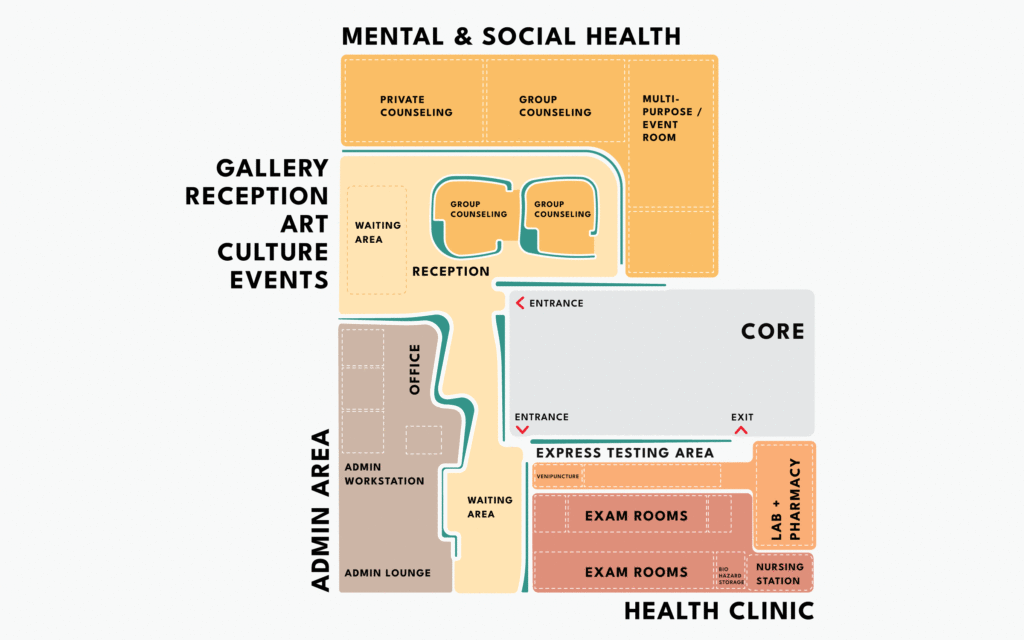HQ Toronto is a welcoming health centre in downtown Toronto where all cisgender gay and bisexual men, and two-spirit, transgender, and non-binary people can receive comprehensive, holistic, person-centred services that support their health and well-being.
Occupying more than 9,000 square feet on the eighth floor of 790 Bay Street, this new health hub provides a mix of physical and sexual health clinic spaces; an express testing laboratory for sexually transmitted and blood-borne infections; mental and social health spaces, including private and group counseling rooms; five multi-use rooms that can be converted to accommodate a wide range of activities – teaching, seminars, smudging ceremonies, yoga classes, book clubs, poetry readings, social, and celebratory events; and communal and gathering spaces, including a curated revolving gallery celebrating LGBTQ2S+ culture through the medium of art.
Our challenge was to create a welcoming, nurturing, and supportive environment that speaks to a community, while addressing the highly specialized program and sophisticated technical and clinical needs befitting a leading-edge health centre. It was crucial to create highly functional technical spaces – complete with current expectations for accessibility and infection prevention and control – in an environment that felt decidedly un-clinical.

Our interest in neuro-architecture influences many of our decisions. Evidence supports that the way a person’s brain and body respond to a physical and spatial environment has a profound impact on health, well-being, and behaviour. In this holistic, interdisciplinary approach, no one aspect of the design takes precedence; the design solution artfully integrates a wealth of elements to elicit a positive emotional response including colours, textures, materials, lighting, shapes, acoustics, and furnishings.

Apart from interior designers or architects, most people will not likely recall the look of the environment where their last healthcare appointment took place, few, however, will forget the feelings associated with the experience. It was our overarching objective therefore to enhance the experience of the client by making their visit as positive, comfortable, and stress-free as possible.
Many in the LGBTQ2S+ community have reported negative experiences in the healthcare system and there is widespread distrust and reluctance to access care. For patients waiting to see a physician, or clients accessing mental health/counselling or testing facilities, we recognized the importance of creating a calming environment that would alleviate their anxiety, adopting a hospitality or residential vocabulary where possible. Respect for individual dignity and privacy, independence, and self-governance were also important drivers and reflected the client’s mandate to provide a safe, supportive, and stigma-free environment for the community. To protect clients’ privacy, we created a moveable partition wall to separate the clinical areas from social/gathering/event space, while waiting rooms and group counselling areas feature acoustic gypsum ceiling treatments.

We looked to nature and indigenous Canadian culture for inspiration. The neutral tones of the furnishings and fixtures lend itself to a calming ambiance, while accentuating the colourful art pieces adorning the walls. A semi-circular front desk crafted from stained white oak greets the visitor at the main entry. Natural wood is used in all the common areas to provide a sense of comfort, warmth, as well as sound attenuation while furniture with rounded edges and curved elements was selected to soften the space. The strategic use of sound-attenuated glazing brings natural light as deeply into the building as possible; in other areas, we employed specialty gallery-like lighting to support the displays of curated art and installations.
Prior to the creation of this facility, Toronto was one of the only major North American cities with a large gay and bisexual cisgender male, and two-spirit, transgender, and non-binary population that did not have an integrated health centre to serve this community; now Toronto joins the ranks of San Francisco and Boston as one of the leaders in this new model of holistic care.

